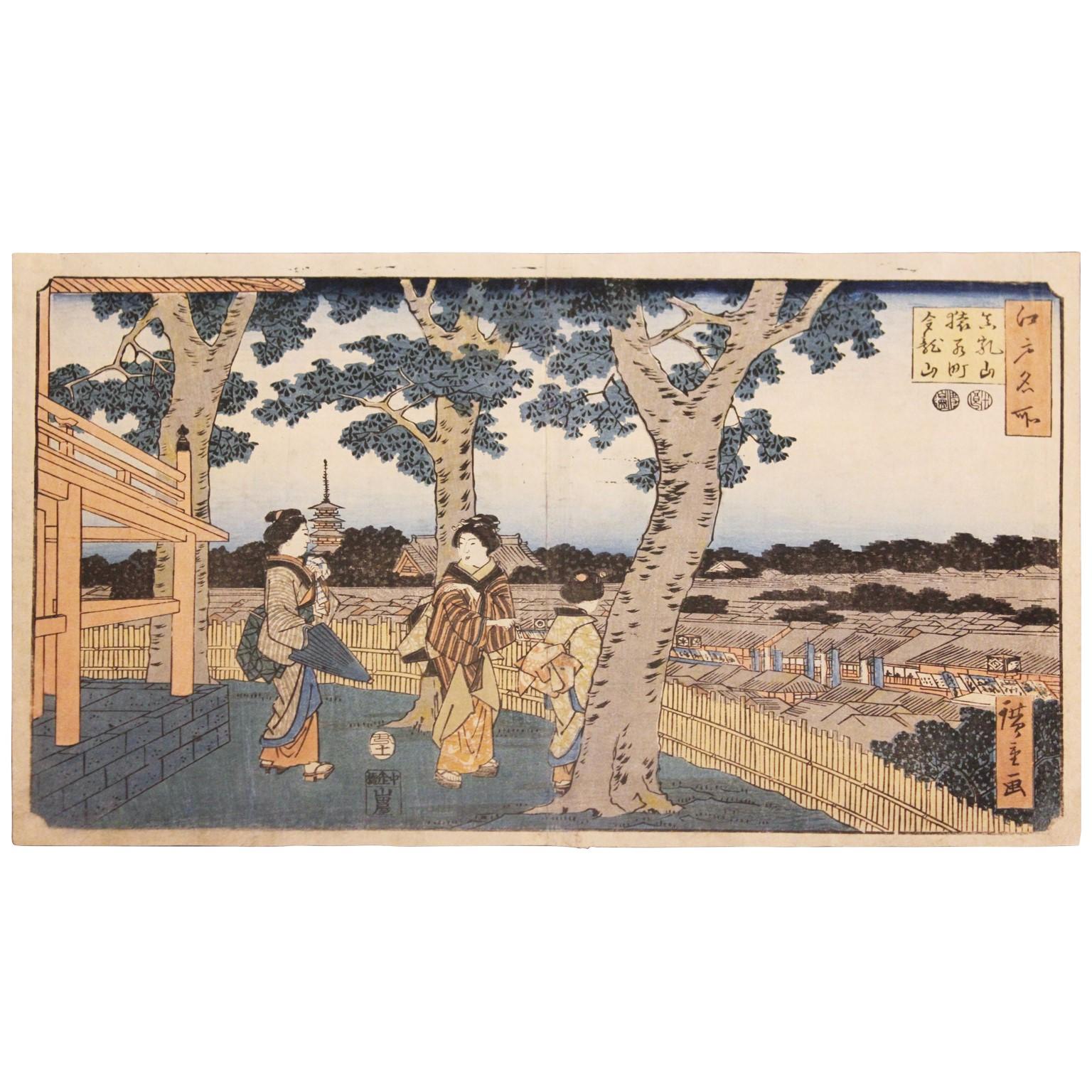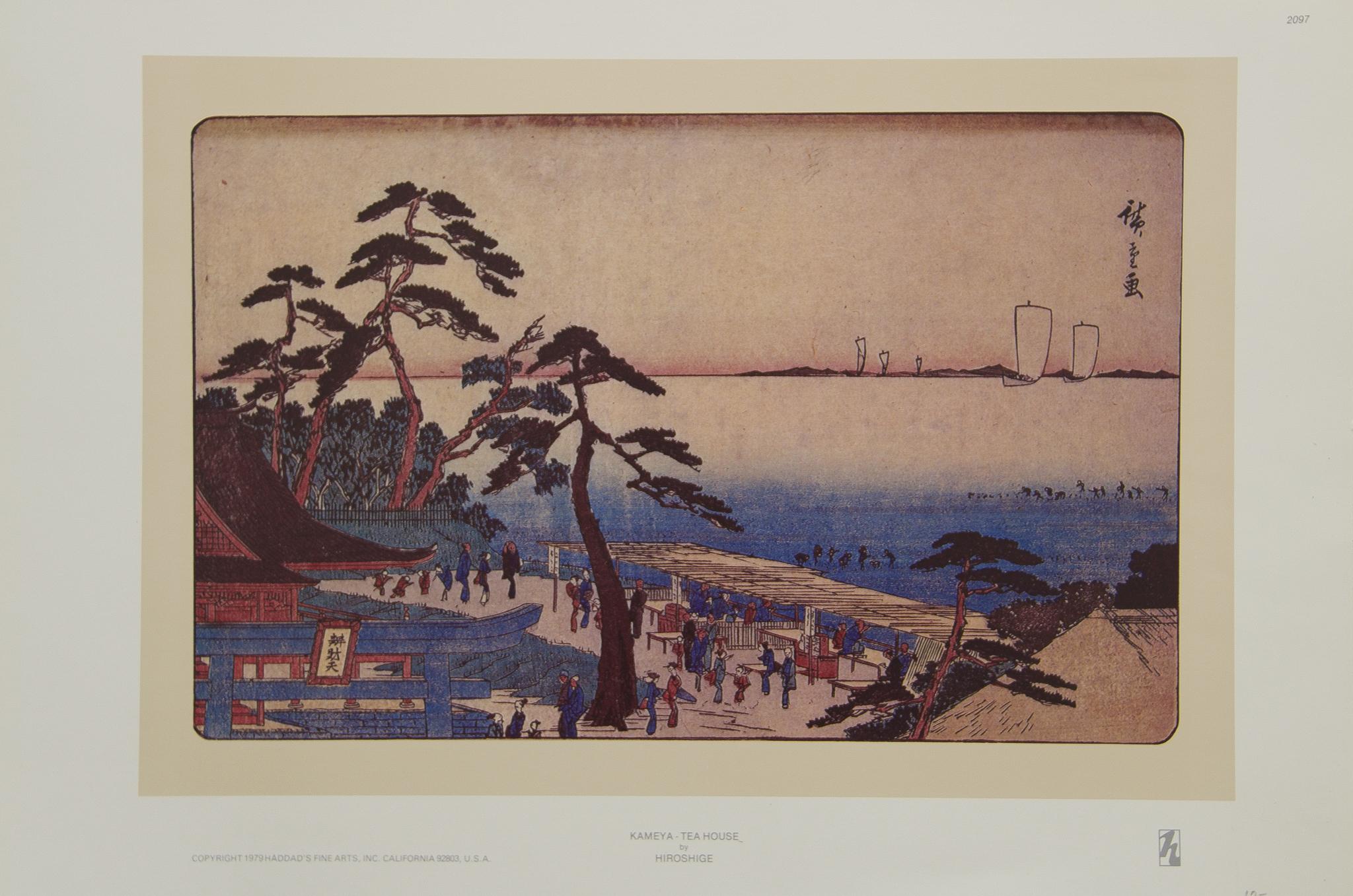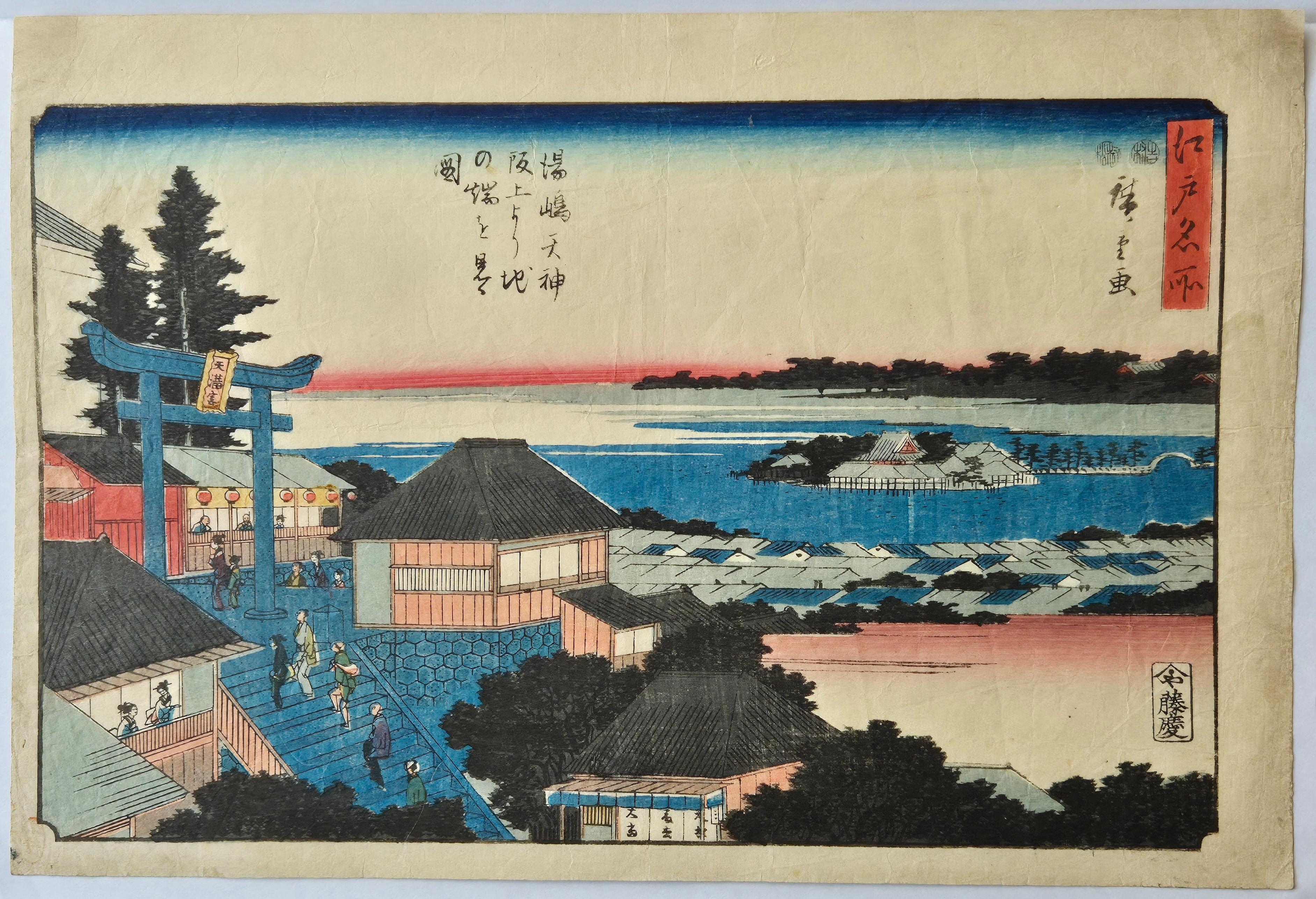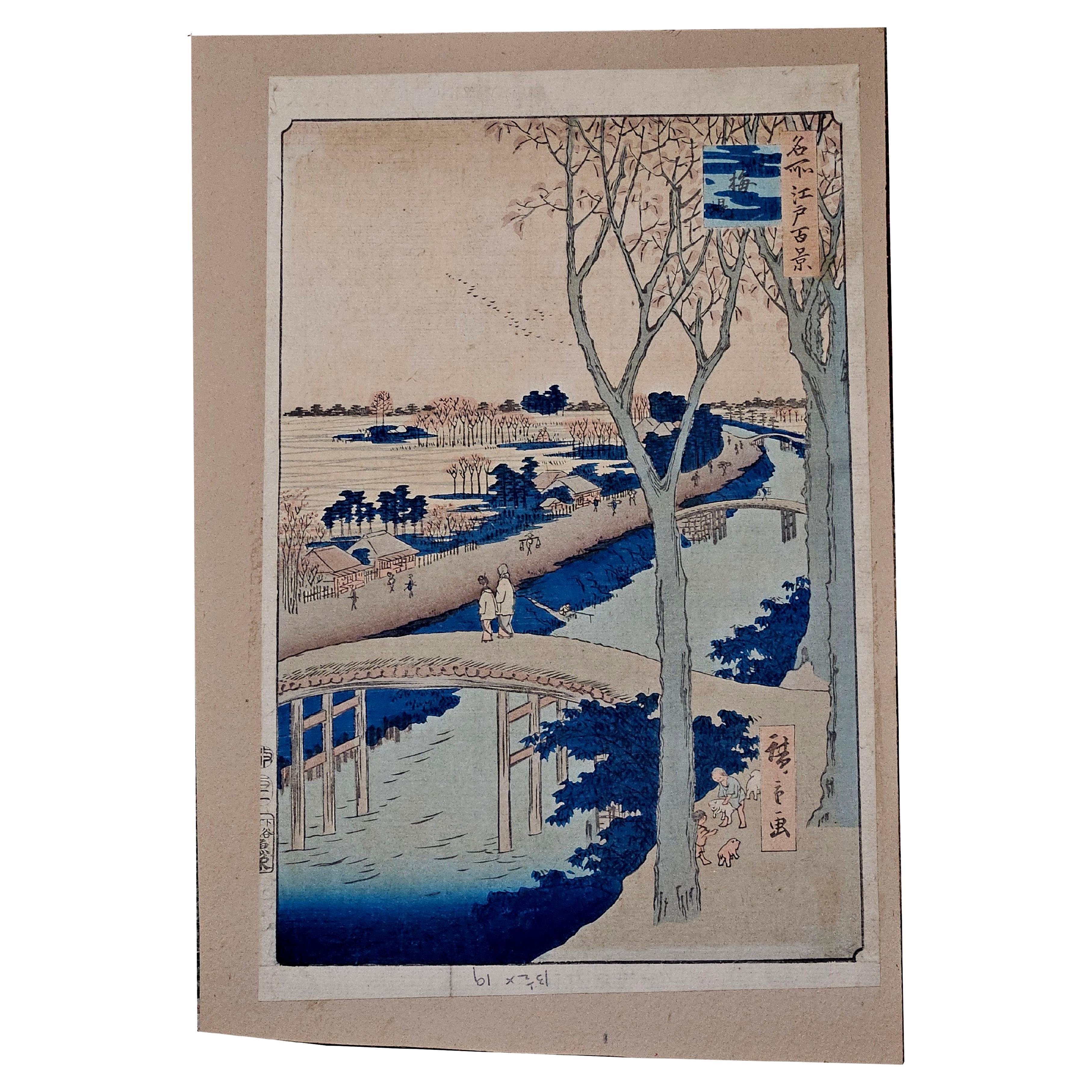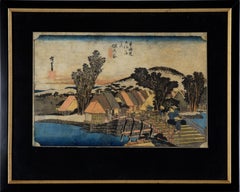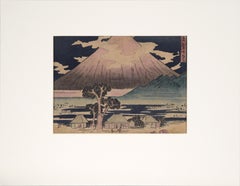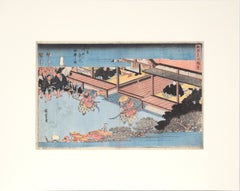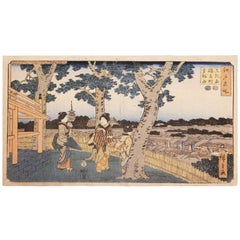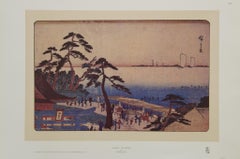Items Similar to Kiyomizu Temple, Scenes of Famous Places along Tôkaidô Road - Woodblock on Paper
Want more images or videos?
Request additional images or videos from the seller
1 of 12
Utagawa Hiroshige IIKiyomizu Temple, Scenes of Famous Places along Tôkaidô Road - Woodblock on Paper1863
1863
$960
$1,20020% Off
£726.31
£907.8820% Off
€838.27
€1,047.8420% Off
CA$1,340.85
CA$1,676.0720% Off
A$1,490.77
A$1,863.4720% Off
CHF 780.33
CHF 975.4120% Off
MX$18,283.83
MX$22,854.7920% Off
NOK 9,935.57
NOK 12,419.4620% Off
SEK 9,380.35
SEK 11,725.4420% Off
DKK 6,255.44
DKK 7,819.3020% Off
Shipping
Retrieving quote...The 1stDibs Promise:
Authenticity Guarantee,
Money-Back Guarantee,
24-Hour Cancellation
About the Item
Kiyomizu Temple, Scenes of Famous Places along Tôkaidô Road - Woodblock on Paper
Full Title:
Kyoto: Kiyomizu Temple (Kyô Kiyomizudera), from the series Scenes of Famous Places along the Tôkaidô Road (Tôkaidô meisho fûkei), also known as the Processional Tôkaidô (Gyôretsu Tôkaidô)
Vibrant woodblock print by Utagawa Hiroshige II (1826-1869). This piece depicts Kiyomizu Temple in Kyoto, as a part of the Tokaido Road series. There temple stands tall above the ground, with a balcony full of people. There are trees in bloom in the courtyard below. Another group of people are walking up the stairs to enter the temple.
Presented in an off-white mat with foamcore backing.
Mat size: 20"H x 16"W
Paper size: 14.5"W x 9.75"W
Hiroshige II, Ni-daime Utagawa Hiroshige, (1826 – 17 September 1869) was a Japanese designer of ukiyo-e art. He inherited the name Hiroshige II following the death in 1858 of his master Hiroshige, whose daughter he married. In 1865 he moved from Edo to Yokohama after dissolving his marriage and began using the name Kisai Rissho (alternate pronunciation: Ryusho). His work so resembles that of his master that scholars have often confused them.
Born Suzuki Chinpei in 1826, it is said that he was born to a fireman, as was his master Hiroshige to whom he became apprenticed under the name Shigenobu at an unknown age. His earliest known work is the illustrations for a book called Twenty-four Paragons of Japan and China from 1849.
Hiroshige II produced a large number of commissioned work in the 1850s in the style of the elder Hiroshige, and often signed his work Ichiryusai mon ("student of Ichiryusai", another art name of Hiroshige I's), and from c.?1853 to 1858 simply as Ichiryusai. In 1858, he married Hiroshige I's daughter Otatsu after the master's death and inherited the Hiroshige name, as well as the names Ichiryusai and Ryusai.
The artist moved from Edo to Yokohama in 1865 after dissolving his marriage and began using the name Kisai Rissho (alternate pronunciation: Ryusho). During this decade he produced a number of collaborative print series, particularly with Kunisada, who had earlier worked with Hiroshige I. In his final years he turned mainly to decorating works intended for export, such as tea chests, kites, and lanterns. On 17 September 1869 he died at the age of 44.
Hiroshige I took on a few students; Hiroshige II was the most successful of these. His works have often been confounded with those of his master, which they resemble closely in style, subject, and signature. Early Western scholars did not even recognize him as a separate artist.
Another pupil of the first Hiroshige, Shigemasa, later married the master's daughter, Otatsu, and also began using the name Hiroshige; this artist now is known as Hiroshige III.
- Creator:Utagawa Hiroshige II (Japanese)
- Creation Year:1863
- Dimensions:Height: 20 in (50.8 cm)Width: 16 in (40.64 cm)Depth: 0.25 in (6.35 mm)
- Medium:
- Movement & Style:
- Period:
- Condition:Good condition, with minor imperfections. One blemish in upper left corner of print. Unfortunately, a previous owner mounted this piece with tape that mostly obscures the artist's signature on the left edge of the paper.
- Gallery Location:Soquel, CA
- Reference Number:Seller: DBH80741stDibs: LU54214028552
About the Seller
5.0
Platinum Seller
Premium sellers with a 4.7+ rating and 24-hour response times
Established in 1986
1stDibs seller since 2014
2,947 sales on 1stDibs
Typical response time: <1 hour
- ShippingRetrieving quote...Shipping from: Soquel, CA
- Return Policy
Authenticity Guarantee
In the unlikely event there’s an issue with an item’s authenticity, contact us within 1 year for a full refund. DetailsMoney-Back Guarantee
If your item is not as described, is damaged in transit, or does not arrive, contact us within 7 days for a full refund. Details24-Hour Cancellation
You have a 24-hour grace period in which to reconsider your purchase, with no questions asked.Vetted Professional Sellers
Our world-class sellers must adhere to strict standards for service and quality, maintaining the integrity of our listings.Price-Match Guarantee
If you find that a seller listed the same item for a lower price elsewhere, we’ll match it.Trusted Global Delivery
Our best-in-class carrier network provides specialized shipping options worldwide, including custom delivery.More From This Seller
View AllShin-machi Bridge at Hodogaya - Japanese Woodcut Print on Rice Paper
By Utagawa Hiroshige
Located in Soquel, CA
Shin-machi Bridge at Hodogaya - Japanese Woodcut Print on Rice Paper
Woodblock print of travelers on a bridge by Utagawa Hiroshige (Japanese, 1797-185...
Category
1850s Impressionist Figurative Prints
Materials
Rice Paper, Woodcut
$1,240 Sale Price
20% Off
Study of Utagawa Hiroshige's "View of Hara-Juku" 53 Stations of the Tokaido Road
By Utagawa Hiroshige
Located in Soquel, CA
Study of Utagawa Hiroshige's "View of Hara-Juku" 53 Stations of the Tokaido Road
Hand painted study of Utagawa Hiroshige's "View of Hara-Juku", (by unknown artist), from "53 Station...
Category
1920s Edo Landscape Prints
Materials
Paper, Ink, Woodcut
$380 Sale Price
20% Off
Sumiyoshi: Dengaku dance performed during an Onda ceremony - Woodblock Print
By Utagawa Hiroshige
Located in Soquel, CA
Sumiyoshi: Dengaku dance performed during an Onda ceremony - Woodblock Print
Bright woodblock print by Utagawa Hiroshige (Japanese, 1797-1858). In this scene, two dancers with swords and fans are facing each other, in the center of a courtyard. There are spectators surrounding them, including nobles in black clothing on a balcony.
Presented in a new off-white mat with foamcore backing.
Mat size: 16"H x 20"W
Paper size: 9.63"H x 14.5W"
Utagawa Hiroshige (1797-1858, sometimes called Ando Hiroshige) was the second of the two great masters of the Japanese landscape woodblock print...
Category
1830s Edo Figurative Prints
Materials
Ink, Rice Paper, Woodcut
"The Kaminarimon at the Kanseon Temple in Asakusa" - Original Japanese Print
Located in Soquel, CA
"The Kaminarimon at the Kanseon Temple in Asakusa" - Original Japanese Print
Japanese Print "The Kaminarimon at the Kanseon Temple in Asakusa", from the series "Famous Places in Ed...
Category
1850s Showa Figurative Prints
Materials
Rice Paper, Woodcut
Kiyomi Barrier & Seiken Temple Near Okitsu- Japanese Woodcut Print on Rice Paper
By Utagawa Hiroshige
Located in Soquel, CA
Kiyomi Barrier & Seiken Temple Near Okitsu - Japanese Woodcut Print on Rice Paper
Woodblock print of boats in a harbor by Utagawa Hiroshige (Japanese, 1797-1858). Originally publish...
Category
1850s Impressionist Figurative Prints
Materials
Rice Paper, Woodcut
Stage 48 of the 53 Stages of the Tokaido - Japanese Woodblock on Rice Paper
By Utagawa Hiroshige
Located in Soquel, CA
Stage 48 of the 53 Stages of the Tokaido - Japanese Woodblock on Rice Paper
Woodblock print of clothing vendors by Utagawa Hiroshige (Japanese, 1797-1858). Originally printed in 183...
Category
1830s Impressionist Figurative Prints
Materials
Rice Paper, Woodcut
You May Also Like
Saruwaka-machi District and Kinryûzan Temple Seen from Matsuchiyama
By Utagawa Hiroshige (Ando Hiroshige)
Located in Houston, TX
Three women in the Saruwaka-machi District with a view of Kinryûzan Temple seen from the famous landmark Matsuchiyama. The woodblock print is from the series "Famous Places in Edo". ...
Category
1850s Edo Figurative Prints
Materials
Woodcut
Kameya - Tea House
By Utagawa Hiroshige (Ando Hiroshige)
Located in Chesterfield, MI
Kameya - Tea House Lithography by Utagawa Hiroshige (Ando Hiroshige)
Print in Good Condition
Measures 12.5 in x 19 in
Category
Early 18th Century Landscape Prints
Materials
Lithograph
$120 Sale Price
20% Off
Utagawa Hiroshige -- Looking toward Ikenohata from the Hill of the Yushima Tenji
By Utagawa Hiroshige (Ando Hiroshige)
Located in BRUCE, ACT
Utagawa Hiroshige (Ando Hiroshige)
Looking toward Ikenohata from the Hill of the Yushima Tenjin Shrine (Yushima Tenjin sakaue yori Ikenohata o miru zu), from the series Famous Places...
Category
1840s Prints and Multiples
Materials
Woodcut
Utagawa Hiroshige 歌川廣重 Woodblock Print, Koume Embankment
Located in Norton, MA
Utagawa Hiroshige (1797–1858)
One Hundred Famous Views of Edo - Koume Embankment
mounted on a cardboard
Artist:
Utagawa Hiroshige is recognized as a master of the ukiyo-e woodblock ...
Category
Antique 19th Century Japanese Prints
Materials
Paper
Hiroshige Utagawa, The Suruga District in Edo
By Utagawa Hiroshige
Located in Torino, IT
HIROSHIGE UTAGAWA I, Edo 1797 - 1858
The Suruga District in Edo (Tôto Suruga-chô), from the series Thirty-six Views of Mount Fuji (Fuji sanjûrokkei)
Nishiki-e. Color woodcut, signed...
Category
1850s Edo Landscape Prints
Materials
Woodcut
Hiroshige (1797-1858) - Ueno Yamashita
By Utagawa Hiroshige (Ando Hiroshige)
Located in BRUCE, ACT
Artist: Utagawa Hiroshige (Hiroshige Ando 1797-1858)
Title: No.12 Ueno Yamashita
Series: One Hundred Famous Views of Edo (名所江戸百景)
Size: O-ban 大判
Age: 1858
Category
1850s Landscape Prints
Materials
Woodcut
$4,240 Sale Price
20% Off
More Ways To Browse
Tea Chest
Japanese Paper Lantern
Chinese Woodblock
As Above So Below
Antique Tea Chest
Antique Tea Chests
Antique Chinese Lantern
Antique Marriage Chests
Antique Paper Lantern
Chinese Elders
Chinese Paper Lanterns
Chinese Lanterns In Art
Chinese Kite
Antique Firemans
Chinese Tea Chest Antique
Japanese Fireman
Antique Japanese Tea Chest
Vintage Ski Posters Chamonix
